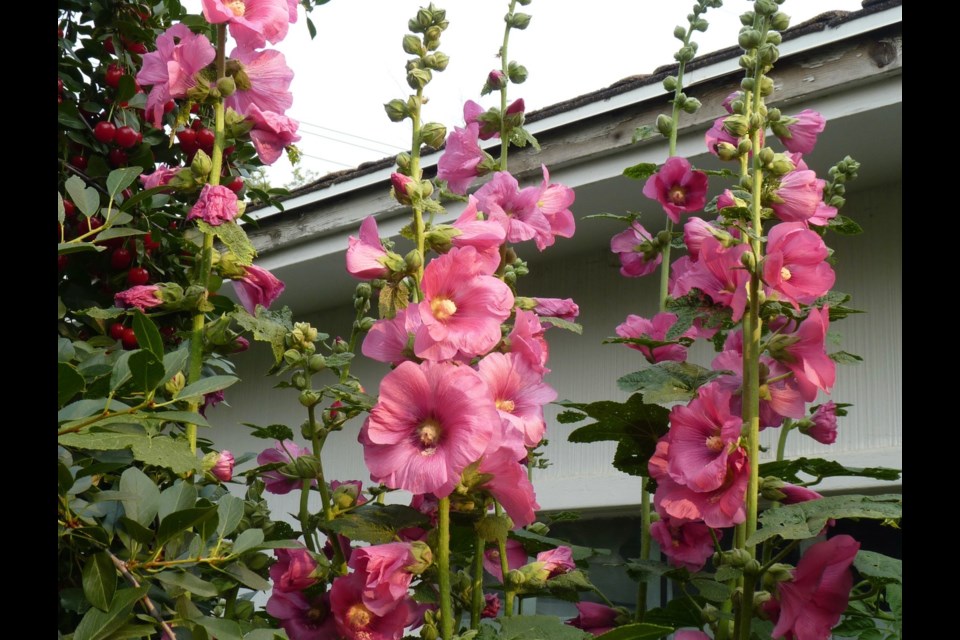Hollyhocks (Alcea rosea, syn. Althaea rosea) are old-fashioned cottage garden plants which, to this day, remain as popular as ever. They have been variously classified as annuals, biennials or short-lived perennials – which can be a source of confusion for gardeners. Annual varieties germinate, flower and die in their first season. Biennials grow vegetatively in their first year and flower and then die in their second year. Perennial varieties grow vegetatively in their first season and flower thereafter but are generally short-lived. But if allowed to self-seed in an un-mulched bed, the planting itself can be treated as perennial.
Introduced into Britain in 1573, they probably came from their native China by way of Palestine, introduced to Europe from the Middle East around the year 1500 by crusaders returning from the holy wars. They quickly became a staple of medieval gardens.
The name hollyhock is thought to be derived from the Anglo-Saxon term, ‘holy-hoc’ (the herbalist, William Turner, referred to them as "holyoke") or holy mallow – mallow 小蓝视频 a common name given to all members of the althea family.
Althea comes from the Greek, altheo, meaning, to cure – as it was once used to heal tuberculosis, and bladder inflammations as well as soothe swollen horses’ heels. In herbal medicine, hollyhocks have been used as an emollient to soften the skin as well as a laxative, to control inflammation, to stop bedwetting and as a mouthwash to ease bleeding gums. In Tudor times hollyhock blooms, steeped in wine, were used to prevent miscarriages. Difficult labours were soothed by ingesting hollyhock shoots. Babies were encouraged to chew on young hollyhocks when teething.
The variety ‘Nigra’ was first described in 1629. Its huge black-red flowers have been prized for centuries and remain popular today. William Chater, through his Saffron Walden Nursery in England in his 1847 seed catalogue, offered reliably double flowering hollyhocks of larger size and substance and in colours not previously seen. Chater’s Double, released in the 1880s, became one of the most popular hollyhocks of all time.
The flowers, either single or double, and up to 8 cm (3.5 inches) in diameter, bloom from late summer (July and August) into fall. Colours include white, pink, yellow, red and purple, some so dark a purple as to appear almost black. Although up to 8 feet in height, their usually sturdy stems generally do not require staking – although they may need support in a windy location. The leaves are large and heart-shaped. Single-flower hollyhocks attract hummingbirds and butterflies.
Leaf rust, a common hollyhock disease, first appears as small round yellow-orange pustules on the undersides of the lower leaves. Larger orange spots with red centres follow on the upper leaf surface. The disease can quickly spread to other leaves and stems. Remove infected parts but do not dispose of them in your compost pile. Resistant varieties are available.
Hollyhocks are easily grown from seed. Lightly covered, they germinate at room temperature (72/22C) in 5-10 days. And once established, they readily self-seed. Transplant 20-30 days from seeding. Biennials flower their second year.
Due to their height, they are best placed along a fence or wall or at the back of a border. Give them protection from the wind. Hollyhocks do best in full sun in fertile soil with even moisture and good air circulation. Space about 2 feet apart. Fertilize in spring.
This column is provided courtesy of the Saskatchewan Perennial Society (SPS; [email protected]). Check our website () or Facebook page () for a list of upcoming gardening events.




